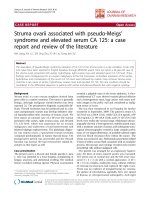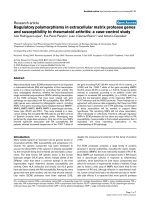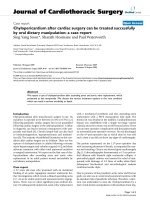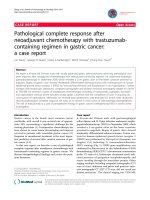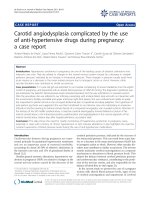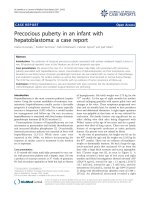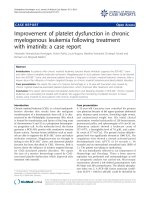Báo cáo y học: "Aorto-venous fistula between an abdominal aortic aneurysm and an aberrant renal vein: a case report" ppsx
Bạn đang xem bản rút gọn của tài liệu. Xem và tải ngay bản đầy đủ của tài liệu tại đây (1.33 MB, 4 trang )
CAS E REP O R T Open Access
Aorto-venous fistula between an abdominal
aortic aneurysm and an aberrant renal vein:
a case report
Mélanie Faucherre
1*
, Nader Haftgoli-Bakhtiari
1
, Markus Menth
3
, Julien Gaude
4
, Beat Lehmann
2
Abstract
Introduction: The potential complications of an abdominal aortic aneurysm include rupture, compression of
surrounding structures, thrombo-embolic events and fistula. The most common site of arterio-venous fistula is the
inferior vena cava. Fistula involving a renal vein is particularly uncommon.
Case presentation: This report describes a 54-year-old Caucasian woman who was admitted to the emergency
department with fatigue, severe dyspnea and bilateral lower limb edema. In the first instance this anamnesis
suggested possible heart failure. In fact, our patient presented with multi-organ system failure due to a fistula
between an infra-renal aortic aneurysm and an aberrant retro-aortic renal vein.
Conclusions: To our knowledge, this is the first report of a woman with a fistula betwe en an infra-renal aortic
aneurysm and an aberrant retro-aortic left renal vein. Aorto-venous fistulas may be asymptomatic or may present
with symptoms characteristic of arterio-venous shunting and/or aneurysm rupture. This type of fistula is a rare
cause of heart failure. Clinical examination and imaging are essential for detection.
Introduction
The most common complication of abdominal aortic
aneurysm (AAA) is rupture. Direct ruptures into a
nearby organ, such as the duodenum and the venous
system remain very rare [1]. Fistula involving a renal
vein is particularly uncommon [2].
Aorto-venous fistulas may be asymptomatic or may
present w ith symptoms characteristic of arterio-venous
shunting and/or aneurysm rupture [3]. Symptoms such
as chest pain, signs of acute heart failure with or with-
out electrocardiographic signs of acute coronary ische-
mia or a long history of chronic heart failure resistant to
therapy are often present [1]. The classic triad of clinical
symptoms and signs in the AAA patients with aorto-
caval fistula are abdominal or back pain (or both), a pul-
satile mass, and an abdominal bruit. In a review of 148
reported cases, Gilling-Smith et al.reportedthatthis
classic triad is present in only 63% [4]. The extent of
the clinical manifestations of a fistula between an AAA
and the venous system depends on the size, duration
and location of the fistula [5].
This report describes a 54-year-old Caucasi an woman
who was admitted to the emergency department with
fatigue, severe dyspnea and bilateral lower limb edema.
In the first instance this anamnesis suggested possible
heart failure. In fact, our patient presented with multi-
organ system failure due to a fistula between an infra-
renal aortic aneurysm and an aberrant retro-aortic renal
vein.
Case presentation
A 54-year-old Caucasian woman was referred to our
emergency department for heart failure associated with
dyspnea and bilateral lower limb edema, which had per-
sisted for two months. Her past medical history is signif-
icant for hypertension and obesity (body mass index:
34 kg/m
2
).
On admission to hospital, her blood pressure was 120/
70 mmHg and heart rate 90/min; there was a systolic
murmur (3/6) which was predominant at th e apex; dis-
tension of the jugular vein indicating elevation of central
venous pressure and there was pitting edema of both
* Correspondence:
1
Department of Internal Medicine, Cantonal Hospital, Fribourg, 1700,
Switzerland
Full list of author information is available at the end of the article
Faucherre et al. Journal of Medical Case Reports 2010, 4:255
/>JOURNAL OF MEDICAL
CASE REPORTS
© 2010 Faucherre et al; licensee BioMed Central Ltd. This is an Open Access article dist ributed under the terms of the Creati ve
Commons Attribution License ( which permits unrestricted use, distribution, and
reproductio n in any medium , provided the original work is properly cited.
legs. Thoracic percussion revealed a right basal dullness
that was compatible with pleural effusion. These signs
were suggestive of heart failure. On abdominal ausculta-
tion, a systolo-diastolic murmur was audible. Further-
more, we observed hematomas on both arms and legs.
Ultrasound showed an AAA, a vascular structure behind
the AAA, as well as a massively dilated inferior vena
cava with arterial flo w velocity features (Figure 1). The
results of laboratory tests revealed liver dysfunction
(aspartate aminotransferase (ASAT) 120 IU/L, refer ence
value (rv): <40 U/L; bilirubin 51.1 μmol/L, rv: 3.1-18.8
μmol/L and lactate dehydrogenase (LDH) 979 IU/L, rv:
<450 IU/L), renal failure (serum creatinin 241 μmol/L,
rv: 50-95 μmol/L), thrombocytopenia (80 G/L, rv: 150-
300 G/L) as well as coagulation disturbances (PT: 33%,
rv: 70-100%; PTT: 42 s, rv: 26-35 s; fibrinogen: 0.7 g/L,
rv:2-4.5g/L).Acomputedtomography (CT) scan con-
firmed a partially thrombosed AAA with a maximal
antero-posterior diameter of 4.2 cm. A f lush of intrave-
nous contrast product was detected in the left (aberrant)
renal vein immediately after injection due to a fistula
between the AAA and the aberrant left renal vein
(Figures 2 and 3).
Arteriovenous shunt resulted in an increase of venous
return, pressure and volume with simultaneous fall in
the peripheral resistances: heart rate, stroke volume, car-
diac output and cardiac work increase as a physiological
response to the overloa d. It induced hyperdynamic car-
diac failure; this explains the perturbation of the liver
and renal function [1]. Moreover, the increase of the
renal venous pressure aggravated this dysfunction.
A xyphopubic laparotomy was performed on the same
day. The surge on clamped the aorta , both iliac arteries
and the inferior vena cava upstream and downstream the
retroaortic renal vein. The hematoma inside the aneur-
ysm was removed. The retro-aortic left renal vein was
ligated. The fistula was plugged with parietal tissue and a
ligature. For the aneurysm, a straight silver graft (with a
diameter of 16 mm) was interposed; the aorto-prosthetic
and termino-terminal anastomoses were completed with-
out complication. During the operation, the cell saver
collected 6200 mL. A biopsy of the aneurysm wall was
sent to a pathology institute; analysis revealed rare elastic
Figure 1 Abdominal ultrasound at the emergency departme nt
demonstrating the presence of a vascular structure behind the
abdominal aortic aneurysm with a mixed arterio-venous flow
due to the arterio-venous fistula.
Figure 2 Contrast CT scan at the emergency department
confirming the fistula between AAA and the aberrant left renal
vein.
Figure 3 3D contrast CT showing abdominal aortic aneurysm
and the dilated inferior cava vein.
Faucherre et al. Journal of Medical Case Reports 2010, 4:255
/>Page 2 of 4
fibers, a fibro-muscular hyperplasia of the tunica intima
and atheroma. Microbiological analyses were negative.
Her post-operative course was favorable with both liver
and renal function tests returning to normal.
Discussion
By definition, an AAA is present if there is a dilati on of
the abdominal aorta to a size 50% greater than the prox-
imal norm al segment or to a maximum aortic diameter
greater than 3 cm. The overall prevalence of AAA
ranges between 4 and 8% in men a nd is about 1% in
women [6]. Risks factors for AAA are male sex [7],
smoking, age greater than 65 years and a positiv e family
history. Less important risk factors include e stablished
vascular disease, hypercholesterolemia, low HDL-choles-
terol, hypertension and increased height [8]. Patients
with connective tissue disorders (e.g. Marfan’ ssyn-
drome) or vasculitis (e.g. Takayasu arteritis or giant-cell
arteritis) are particularly at risk of developing an AAA.
People with diabetes and women are at lower risk of
developing AAA [8]. AAAs are often asymptomatic
until rupture. The risk of rupture increases with the
increasing diameter of the aneurysm.
Clinical examination and imaging are essential to
detect AAA. The sensitivity of abdominal palpation [9]
increases significantly with the diameter of the AAA. In
a pooled analysis of 15 studies of abdominal palpation
for AAA detection, the sensitivity ranged from 29% to
76% and the positive predictive value was about 43% [6].
Palpation of AAA appears to be safe and has not been
reported to precipitate rupture. Screening abdominal
ultrasound in asymptomatic individuals is an accurate
test, with 95% sensitivity and near 100% specificity to
detect aneurysms greater than 3.0 cm [8]. CT and mag-
netic resonance imaging provide high-resolution imaging
of the aorta and determine proximal and distal bound-
aries of the aneurysm [6]. A fistula should be suspected
if there is a flush of contrast product in a dilated venous
system immediately after the injection.
The potential complications of AAA include rupture,
fistulas, compression of surrounding structures, infec-
tions and thrombo -embolic events. The most common
complication of AAA is rupture, either into the retro-
peritoneum or into the abdominal cavity. Direct rupture
into a nearby organ, such as the duodenum or the
venous system, or the infra-renal vena cava, renal v ein
or the primary iliac vein, remain very rare and is often
discovered peri-operatively [1]. The most common site
of arterio-venous fistula is the inferior vena cava; iliac
and renal veins are only rarely affected. According to
the literature, the incidence of aorto-caval fistulas is low,
ranging from 0.22 to 6.04% of all AAA [10]. Fistulas
involving a renal vein are particularly uncommon [2].
Aorto-venous fistulas may be asymptomatic or may
present w ith symptoms characteristic of arterio-venous
shunting and/or aneurysm rupture [3]. The typical clini-
cal findings are abdominal, lumbar or flank pain, pulsa-
tile abdominal mass with continuous abdominal bruit or
thrill, signs of conge stive heart failure an d hematuria.
Symptoms such as chest pain, sig ns of acute heart fail-
ure with or without electrocardiographic signs of acute
coronary ischemia or a long history of chronic heart fail-
ure resistant to therapy are often present [1]. The classic
triad of c linical symptoms and signs in AAA patients
with aorto-caval fistula are abdominal or back pain (or
both), a pulsatile mass, and an abdominal bruit. In a
review of 148 reported cases, Gilling-Smith et al.
reported that this classic triad is present in only 63%
[4]. The extent of the clinical manifestations of a fistula
between an AAA and the venous system depends on the
size, duration and location of the fistula [5].
Retroaortic renal veins are found in 1.8% of aut opsies.
Signs and symptoms of aorto-renal vein fistulas are
similar to those of ureteral colic, and form a unique
group of patients with aorto-venous fistula. Left flank
pain and hematuria are present in almost all reported
cases. Heart failure is rare in this situation, which is pre-
sumably explained by the relatively small volume of fis-
tula flow usually present [11].
Conclusions
Early diagnosis is crucial in the management of aorto-renal
vein fistulas. Acting on a high level of suspicion, a careful
clinical examination, followed by imaging studies (ultra-
sound) can provide further information. Pre-operative
diagnosis can be accomplished with the careful interpreta-
tion of CT scans that gives rapidly precise information.
The results of surgical treatment for this condition have
been favorable when pre-operative localization has been
precise and the operative technique cautious [4]. Problems
in the treatment of aorto-caval fistula include poor patient
condition due to hemorrhagic shock, high-output heart
failure, renal failure and intra-operative bleeding. Usually,
cardiac and renal abnormalities are rapidly reversed after
surgical closure of the fistula.
Arterio-venous fistula is a rare but well k nown cause
of heart failure. A pulsatile abdominal mass and an
abdominal murmur should be followed by imaging stu-
dies ( ultrasound, CT scan), and a definitive diagnosis is
usually made by CT scanning. Treatment is by surgical
repair with a bifurcated graft, a straight tube graft, and
endovascular aneurysm repair (EVAR). Usually, cardiac
and renal abnormalities are rapidly reversed after surgi-
cal closure of the fistula.
Faucherre et al. Journal of Medical Case Reports 2010, 4:255
/>Page 3 of 4
List of abbreviations
AAA: abdominal aortic aneurysm; ASAT: aspartate aminotransferase; CT:
computed tomography; HDL: high-density lipoprotein; IU/L: international
units per liter; LDH: lactate dehydrogenase; PT: prothrombin time; PTT:
activated partial thromboplastin time; RV: reference value.
Competing interests
The authors declare that they have no competing interests.
Authors’ contributions
MF and BL supervised the case at the emergency department, contributed
to the literature research. MF wrote this case report with BL as a contributor.
NH and MM contributed to analysis and interpretation of the clinical and
radiological findings of the patient. JG interpreted the CT scan. All authors
read critically and approved the manuscript.
Consent
Written informed consent was obtained from the patient for the publication
of this case report and any accompanying images. A copy of the written
consent is available for review by the Editor-in-Chief of this journal.
Author details
1
Department of Internal Medicine, Cantonal Hospital, Fribourg, 1700,
Switzerland.
2
Emergency Department, Cantonal Hospital, Fribourg, 1700,
Switzerland.
3
Department of Surgery, Cantonal Hospital, Fribourg, 1700,
Switzerland.
4
Department of Radiology, Cantonal Hospital, Fribourg, 1700,
Switzerland.
Received: 22 October 2009 Accepted: 8 August 2010
Published: 8 August 2010
References
1. Abbadi AC, Deldime P, Van Espen D, Simon M, Rosoux Ph: The
spontaneous aortocaval fistula: a complication of the abdominal aortic
aneurysm. J Cardiovascular Surgery 1998, 39:433-436.
2. Barrier P, Otal P, Garcia O, Vahdat O, Domenech B, Lannareix V, Joffre F,
Rousseau H: Aorto-left renal vein fistula complicating an aortic aneurysm:
preoperative and postoperative multislice CT findings. Cardiovasc
Intervent Radiol 2007, 30(3):485-487.
3. Tsolakis JA, Papadoulas S, Kakkos SK, Skroubis G, Siablis D, Androulakis JA:
Aortocaval fistula in ruptured aneurysms. Eur J Vasc Endovasc Surg 1999,
17:390-393.
4. Gilling-Smith GL, Mansfield AO: Spontaneous abdominal arteriovenous
fistulae: report of eight cases and review of the literature. Br J Surg 1991,
78(4):421-425.
5. Yagdi T, Atay Y, Engin C, Ozbek SS, Buket S: Aorta-left renal vein fistula in
a woman. Texas Heart Institute Journal 2004, 31:435-438.
6. Pande Reena L, Beckman Joshua A: Abdominal aortic aneurysm:
populations risk and how to screen. J Vasc Interv Radiol 2008, 19:S2-S8.
7. Singh K, Bønaa KH, Jacobsen BK, Bjørk L, Solberg S: Prevalence and risk
factors for abdominal aortic aneurysms in a population-based study. Am
J Epidemiology 2001, 154:236-244.
8. U.S Preventive Services Task Force: Screening for abdominal aortic
aneurysm: recommandation statement. Annals of Internal Medicine 2005,
142:198-202.
9. Lederle Franck A, Simel David L: Does this patient have abdominal aortic
aneurysm? JAMA 1999, 281:77-82.
10. Cinara IS, Davidovic LB, Kostic DM, Cvetkovic SD, Jakovljevic NS, Koncar IB:
Aorto-caval fistulas: a review of eighteen years experience. Acta Chir Belg
2005, 105:616-620.
11. Katz Steven G, Kohl Roy D: Spontaneous rupture of an aortic aneurysm
into the left renal vein. Journal Cardiovascular Surgery 1990, 31:479-481.
doi:10.1186/1752-1947-4-255
Cite this article as: Faucherre et al.: Aorto-venous fistula between an
abdominal aortic aneurysm and an aberrant renal vein: a case report.
Journal of Medical Case Reports 2010 4:255.
Submit your next manuscript to BioMed Central
and take full advantage of:
• Convenient online submission
• Thorough peer review
• No space constraints or color figure charges
• Immediate publication on acceptance
• Inclusion in PubMed, CAS, Scopus and Google Scholar
• Research which is freely available for redistribution
Submit your manuscript at
www.biomedcentral.com/submit
Faucherre et al. Journal of Medical Case Reports 2010, 4:255
/>Page 4 of 4
